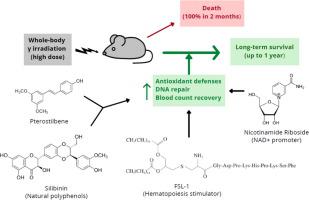Journal of Advanced Research ( IF 10.7 ) Pub Date : 2022-05-13 , DOI: 10.1016/j.jare.2022.05.005 Elena Obrador 1 , Rosario Salvador-Palmer 1 , Blanca Pellicer 2 , Rafael López-Blanch 1 , J Antoni Sirerol 1 , Juan I Villaescusa 3 , Alegría Montoro 3 , Ryan W Dellinger 4 , José M Estrela 1

|
Introduction
Effective agents that could confer long-term protection against ionizing radiation in vivo would have applications in medicine, biotechnology, and in air and space travel. However, at present, drugs that can effectively protect against lethal ionizing radiations are still an unmet need.
Objective
To investigate if combinations of natural polyphenols, known for their antioxidant potential, could protect against ionizing radiations.
Methods
Plant-derived polyphenols were screened for their potential ability to confer radioprotection to mice given a lethal whole-body γ radiation (137Cs) dose expected to kill 50% of the animals in 30 days. Telomere and centromere staining, Q-FISH and comet assays were used to investigate chromosomal aberration, micronuclei formation and DNA breaks. Molecular oxidations were investigated by enzyme immunoassays and UPLC-MS/MS. RT-PCR, western blotting and siRNA-induced gene silencing were used to study signaling mechanisms and molecular interactions.
Results
The combination of pterostilbene (PT) and silibinin (SIL) was the most effective against γ-irradiation, resulting in 100% of the mice surviving at 30 days and 20% survival at one year. Treatment post γ-irradiation with two potential radiomitigators nicotinamide riboside (NR, a vitamin B3 derivative), and/or fibroblast-stimulating lipoprotein 1 (FSL1, a toll-like receptor 2/6 agonist), did not extend survival. However, the combination of PT, SIL, NR and FSL1 achieved a 90% survival one year post γ-irradiation. The mechanism involves induction of the Nrf2-dependent cellular antioxidant defense, reduction of NF-kB signaling, upregulation of the PGC-1α/sirtuins 1 and 3 axis, PARP1-dependent DNA repair, and stimulation of hematopoietic cell recovery. The pathway linking Nrf2, sirtuin 3 and SOD2 is key to radioprotection. Importantly, this combination did not interfere with X-ray mediated killing of different tumor cells in vivo.
Conclusion
The combination of the radioprotectors PT and SIL with the radiomitigators NR and FSL1 confer effective, long-term protection against γ radiation in vivo. This strategy is potentially capable of protecting mammals against ionizing radiations.
中文翻译:

天然多酚与 NAD+ 前体和 TLR2/6 配体脂肽的组合可保护小鼠免受致命的 γ 辐射
介绍
可以在体内提供长期抗电离辐射保护的有效试剂将在医学、生物技术以及航空和太空旅行中得到应用。然而,目前,能够有效防止致死性电离辐射的药物仍然是一个未满足的需求。
客观的
研究以抗氧化潜力着称的天然多酚的组合是否可以防止电离辐射。
方法
对植物来源的多酚进行筛选,看它们是否具有为小鼠提供辐射防护的潜在能力,这些小鼠在 30 天内接受了致命的全身 γ 辐射 ( 137 Cs) 剂量,预计会杀死 50% 的动物。端粒和着丝粒染色、Q-FISH 和彗星检测用于研究染色体畸变、微核形成和 DNA 断裂。通过酶免疫测定和 UPLC-MS/MS 研究了分子氧化。RT-PCR、western blotting 和 siRNA 诱导的基因沉默被用来研究信号机制和分子相互作用。
结果
紫檀芪 (PT) 和水飞蓟宾 (SIL) 的组合对 γ 辐射最有效,导致 100% 的小鼠在 30 天后存活,20% 的小鼠在一年后存活。用两种潜在的放射缓解剂烟酰胺核苷(NR,一种维生素 B3 衍生物)和/或成纤维细胞刺激脂蛋白 1(FSL1,一种 Toll 样受体 2/6 激动剂)进行 γ 辐射后治疗,并没有延长生存期。然而,PT、SIL、NR 和 FSL1 的组合在 γ 辐照后一年实现了 90% 的存活率。该机制涉及诱导 Nrf2 依赖性细胞抗氧化防御、减少 NF-kB 信号、上调 PGC-1α/sirtuins 1 和 3 轴、PARP1 依赖性 DNA 修复以及刺激造血细胞恢复。连接 Nrf2、sirtuin 3 和 SOD2 的通路是辐射防护的关键。重要的,体内。
结论
辐射防护剂 PT 和 SIL 与辐射缓解剂 NR 和 FSL1 的组合可提供有效的长期体内γ 辐射防护。这种策略有可能保护哺乳动物免受电离辐射。



























 京公网安备 11010802027423号
京公网安备 11010802027423号